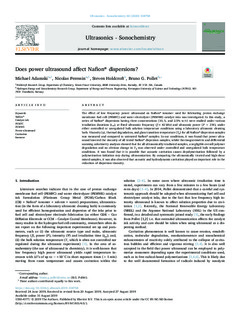| dc.contributor.author | Adamski, Michael | |
| dc.contributor.author | Peressin, Nicolas | |
| dc.contributor.author | Holdcroft, Steven | |
| dc.contributor.author | Pollet, Bruno | |
| dc.date.accessioned | 2019-09-20T09:36:34Z | |
| dc.date.available | 2019-09-20T09:36:34Z | |
| dc.date.created | 2019-09-07T06:51:10Z | |
| dc.date.issued | 2020 | |
| dc.identifier.issn | 1350-4177 | |
| dc.identifier.uri | http://hdl.handle.net/11250/2617994 | |
| dc.description.abstract | The effect of low frequency power ultrasound on Nafion® ionomer used for fabricating proton exchange membrane fuel cell (PEMFC) and water electrolyzer (PEMWE) catalyst inks was investigated. In this study, a series of Nafion® dispersions having three concentrations (10, 5, and 2.5% w/v) were studied under various irradiation durations (tus), at fixed ultrasonic frequency (f = 42 kHz) and ultrasonic power (P > 2 W), under either controlled or unregulated bulk solution temperature conditions using a laboratory ultrasonic cleaning bath. Viscosity (η), thermal degradation, and glass transition temperature (Tg) for all Nafion® dispersion samples was measured and compared to untreated Nafion® samples. In our conditions, it was found that power ultrasound lowered the viscosity of all tested Nafion® dispersion samples; whilst thermogravimetric and differential scanning calorimetry analyses showed that for all ultrasonically irradiated samples, a negligible overall polymer degradation and no obvious change in Tg was observed under controlled and unregulated bulk temperature conditions. It was found that it is possible that acoustic cavitation causes depolymerisation followed by a polymerisation initiation step during ultrasonication. By comparing the ultrasonically treated and high-shear mixed samples, it was also observed that acoustic and hydrodynamic cavitation played an important role in the reduction of dispersion viscosity. | nb_NO |
| dc.language.iso | eng | nb_NO |
| dc.publisher | Elsevier | nb_NO |
| dc.rights | Attribution-NonCommercial-NoDerivatives 4.0 Internasjonal | * |
| dc.rights.uri | http://creativecommons.org/licenses/by-nc-nd/4.0/deed.no | * |
| dc.title | Does power ultrasound affect Nafion® dispersions? | nb_NO |
| dc.type | Journal article | nb_NO |
| dc.type | Peer reviewed | nb_NO |
| dc.description.version | publishedVersion | nb_NO |
| dc.source.journal | Ultrasonics sonochemistry | nb_NO |
| dc.identifier.cristin | 1722494 | |
| dc.description.localcode | (C) 2019 The Authors. Published by Elsevier B.V. This is an open access article under the CC BY-NC-ND license (http://creativecommons.org/licenses/BY-NC-ND/4.0/) | nb_NO |
| cristin.unitcode | 194,64,25,0 | |
| cristin.unitname | Institutt for energi- og prosessteknikk | |
| cristin.ispublished | true | |
| cristin.fulltext | postprint | |
| cristin.qualitycode | 1 | |

